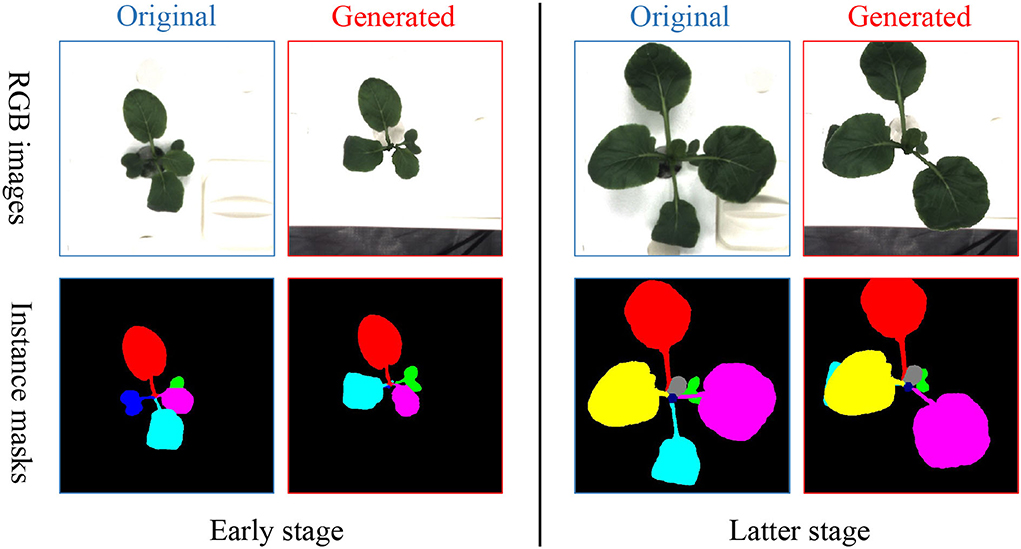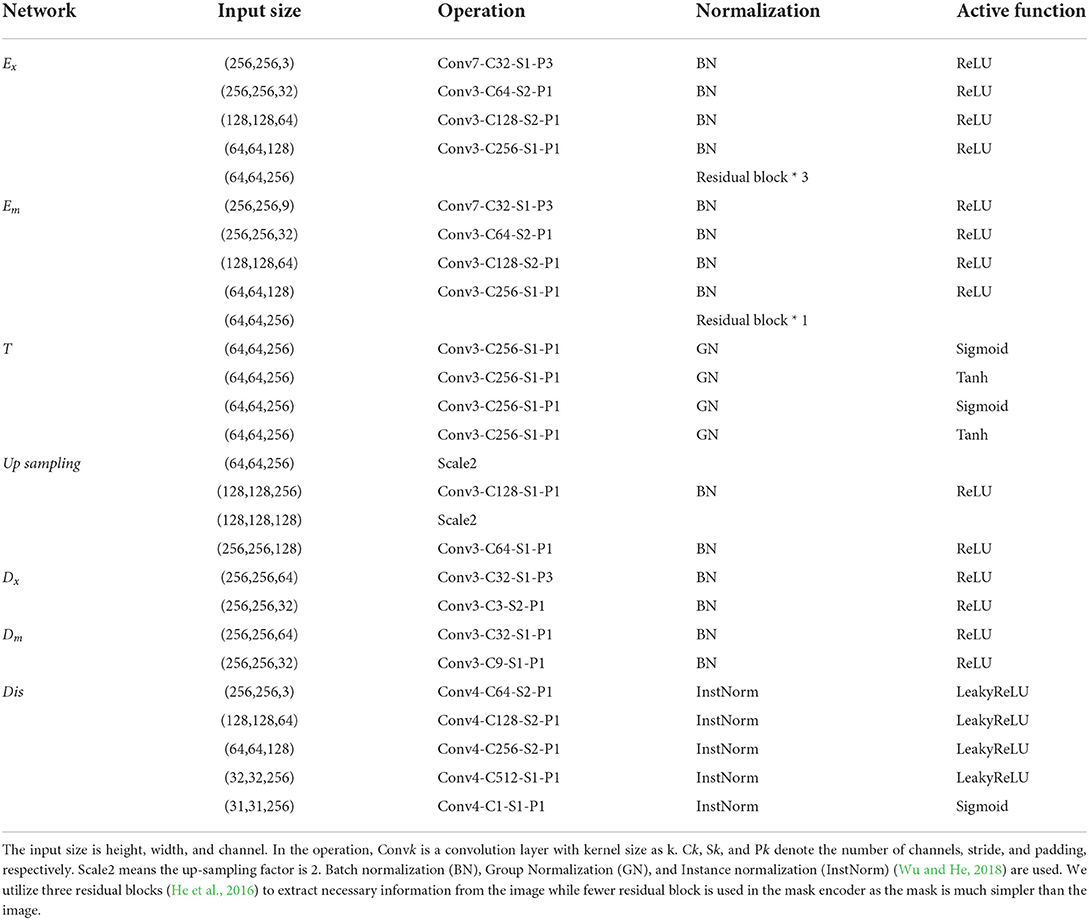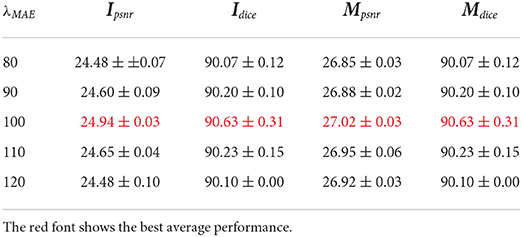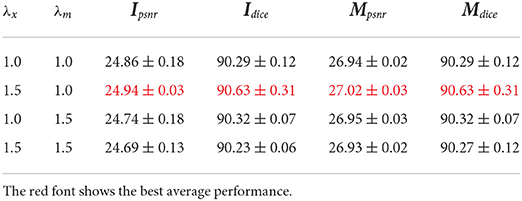- 1Department of Electronics Engineering, Jeonbuk National University, Jeonbuk, South Korea
- 2Core Research Institute of Intelligent Robots, Jeonbuk National University, Jeonbuk, South Korea
- 3Department of Computer Engineering, Mokpo National University, Jeonnam, South Korea
- 4Division of Electronics and Information Engineering, Jeonbuk National University, Jeonbuk, South Korea
Predicting plant growth is a fundamental challenge that can be employed to analyze plants and further make decisions to have healthy plants with high yields. Deep learning has recently been showing its potential to address this challenge in recent years, however, there are still two issues. First, image-based plant growth prediction is currently taken either from time series or image generation viewpoints, resulting in a flexible learning framework and clear predictions, respectively. Second, deep learning-based algorithms are notorious to require a large-scale dataset to obtain a competing performance but collecting enough data is time-consuming and expensive. To address the issues, we consider the plant growth prediction from both viewpoints with two new time-series data augmentation algorithms. To be more specific, we raise a new framework with a length-changeable time-series processing unit to generate images flexibly. A generative adversarial loss is utilized to optimize our model to obtain high-quality images. Furthermore, we first recognize three key points to perform time-series data augmentation and then put forward T-Mixup and T-Copy-Paste. T-Mixup fuses images from a different time pixel-wise while T-Copy-Paste makes new time-series images with a different background by reusing individual leaves extracted from the existing dataset. We perform our method in a public dataset and achieve superior results, such as the generated RGB images and instance masks securing an average PSNR of 27.53 and 27.62, respectively, compared to the previously best 26.55 and 26.92.
1. Introduction
It is estimated that one in ten people worldwide suffered from hunger and nearly one in three people lacked regular access to adequate food in 2021 according to the United Nations1. In addition, 149.2 million children under the age of five suffered from stunting in 2021. Hence, one goal of the United Nations is to end hunger, achieve food security and improved nutrition, and promote sustainable agriculture (Sachs et al., 2022). Simultaneously, high-quality food production has been becoming a high-level social problem in many countries, especially in developing countries mainly because agricultural development and food availability are not compatible with the distribution and changes in population in the world (Xu et al., 2021). Securing a high yield at an affordable cost is one way to mitigate this problem. To achieve this goal, analyzing plant growth under different controlled conditions is essential as they are impacted by many factors such as the supply of fertilizer and water, and further can instruct growers to take early measures when plants are not growing well. Image-based plant growth prediction has been developing in recent years due to the high availability of RGB images and the non-invasiveness of digital cameras, which can be achieved by generating high-quality future images based on previous ones. Deep learning-based methods have recently been showing great potential for image-based plant growth prediction (Somov et al., 2018; Sakurai et al., 2019; Yasrab et al., 2021), however, there are still two challenges.
First, image-based plant growth prediction is currently taken either from time-series or image-generation viewpoints, which leads to a flexible prediction framework (Sakurai et al., 2019) or more clear images (Hamamoto et al., 2020a,b; Yasrab et al., 2021), respectively. On one hand, the time-series task using long-short term memory (LSTM) (Sakurai et al., 2019) allows a changeable length of input and output, which gives more flexibility to train or test a prediction model. On the other hand, the image generation task aims to produce desired images such as high quality and high diversity (Isola et al., 2017), with which conditional generative adversarial network (GAN) loss (Goodfellow et al., 2014) can be leveraged (Hamamoto et al., 2020a; Yasrab et al., 2021) to have high quality generated images. As the advantages of time-series and image generation, we consider the plant growth prediction from both viewpoints to have clear images and a flexible framework simultaneously. Besides, plant growth prediction can be performed on two levels to get diverse information, plant-level and leaf-level. The plant level (Hamamoto et al., 2020a; Jung et al., 2022; Kim et al., 2022) requires generating RGB images, that are visually meaningful to humans, and gives the whole plant situation. In contrast, the leaf-level (Sakurai et al., 2019; Yasrab et al., 2021) demands the assignment of a leaf identity to each plant pixel and thus can be further utilized to analyze each leaf individually. However, current articles tend to perform only one level prediction (Hamamoto et al., 2020a; Yasrab et al., 2021; Jung et al., 2022; Kim et al., 2022). Diversely, we cast predicting RGB image to a regression task but instance mask as a multi-class classification task to have better plant-level and leaf-level prediction simultaneously. Table 1 gives a glimpse of related studies on the prediction content.
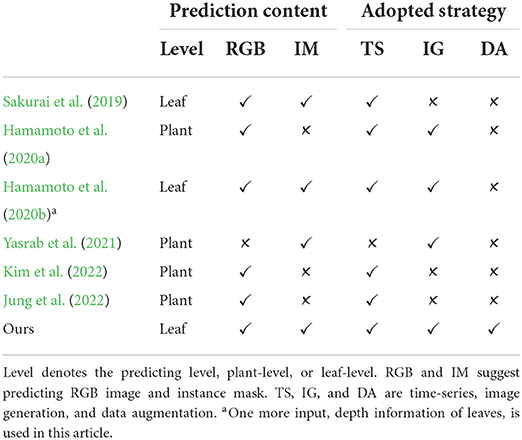
Table 1. Related study is considered from two points, the predicting content and the adopted strategy.
Second, a large-scale dataset is entailed for deep learning-based algorithms in the training process to obtain competitive performance, however, collecting data is time-consuming and expensive in most applications and more inconvenient for plant growth prediction as the time-series character. Although many data augmentation methods have been proposed and verified to address this challenge (DeVries and Taylor, 2017; Zhang et al., 2018; Yun et al., 2019; Xu et al., 2022), the time-series data augmentation algorithm seems underdeveloped. Since plants grow in three-dimensional space over time, three key points can be considered to do data augmentation for plant growth prediction. Time-series first is required in the sense that every plant or leaf should appear in its proper position or size over time. For example, plants or leaves should appear in a similar location, new leaves should be on top of old leaves, and smaller size of plants should exist in the beginning stage, instead of the latter stage. Second, growth characteristics and plant growth characteristics are considered in that every plant or leaf should also grow relatively freely in three-dimensional space while keeping its growth habit. Two popular non-time-series methods, Cutout (DeVries and Taylor, 2017) and Cutmix (Yun et al., 2019), conflict with this requirement in that they may split one leaf and spatially combine two leaves. Third, useful variations are embraced to make the trained model robust (Xu et al., 2022), such as different backgrounds, locations of leaves, and relative positions among leaves. Embracing the three points, we propose two time-series data augmentation, time-series Mixup (T-Mixup) and time-series Copy-Paste (T-Copy-Paste) based on Zhang et al. (2018), Ghiasi et al. (2021). To be more specific, T-Mixup spatially fuses two images, leading to visually no meaningful images, and thus only be leveraged to pre-train our model. T-Copy-Paste consists of two steps where clean backgrounds and desired leaves are first copied and then pasted together to form time-series images. We notice that Copy-Paste is also used as data augmentation for leaf segmentation and counting via combining leaves and backgrounds (Kuznichov et al., 2019), similar to ours but not for time-series data augmentation. As shown in Table 1, little related study considers the data augmentation to mitigate the limited dataset challenge in the plant growth prediction while our experimental results suggest that it significantly contributes to the performance of both RGB image and instance mask.
To summarize, our contributions are as follows:
(1) We consider the plant growth prediction from two perspectives of time series and image generation to generate good-quality images and maintain a flexible framework. Furthermore, we execute plant growth prediction at leaf-level which is more challenging and beneficial to downstream works, instead of just plant-level.
(2) We recognize three key points to perform time-series data augmentation for plant growth prediction, time-series, growth characteristics, and useful variations. Based on these points, we propose two time-series data augmentation, T-Mixup, and T-Copy-Paste, which can also be utilized for other time-series tasks.
(3) We perform our model and data augmentation in the KOMATSUNA dataset (Uchiyama et al., 2017) and achieve superior results. The generated RGB images and instance masks secured PSNR 27.53 and 27.62, compared to the previously best 26.55 and 26.92.
The remainder of this article is organized as follows. The proposed method to do plant growth prediction is instantiated in the next section, including the framework, loss function, and data augmentation method. In the experiments section, we show the implementation to train and test our model, comparison with other methods, ablation study to understand our algorithm, and flexible experiments. Finally, we conclude our study and future study in the last section.
2. Methods
As discussed in the introduction section, we aim to predict plant growth based on images from both time series and image generation viewpoints. Besides, we predict RGB image and leaf instance mask simultaneously to make the downstream application possible and easier. In this section, we first describe the whole framework of our method and the loss function to train the framework. Then two proposed time-series image augmentation algorithms are introduced to facilitate the limitation of the plant growth prediction dataset.
2.1. Framework
As illustrated in Figure 1, our framework consists of three main modules, encoder E, decoder D, and an intermediate time-series processing unit T. Functionally, the encoder is utilized to extract necessary information from the input RGB images and instance masks while the decoder aims to predict the future ones given the historical features from the time-series processing unit T. Differently, T is employed to integrate the multiple time-series features and generate multiple future features. Additionally, individual encoder and decoder for RGB images and instance masks are utilized as their heterogeneity, denoted as Ex, Em, Dx, and Dm. Despite the heterogeneity, we assume that they are useful to predict each other as they are paired in each time step, inspired by multi-task learning (Ruder, 2017). Therefore, they are added element-wise after encoding while becoming specific before decoding. To summarize, the framework has two inputs and two outputs by which we can predict the future q RGB images and instance masks by observing the historical p RGB images xi−p : i and instance masks mi−p : i. Mathematically, our framework can be formalized as:
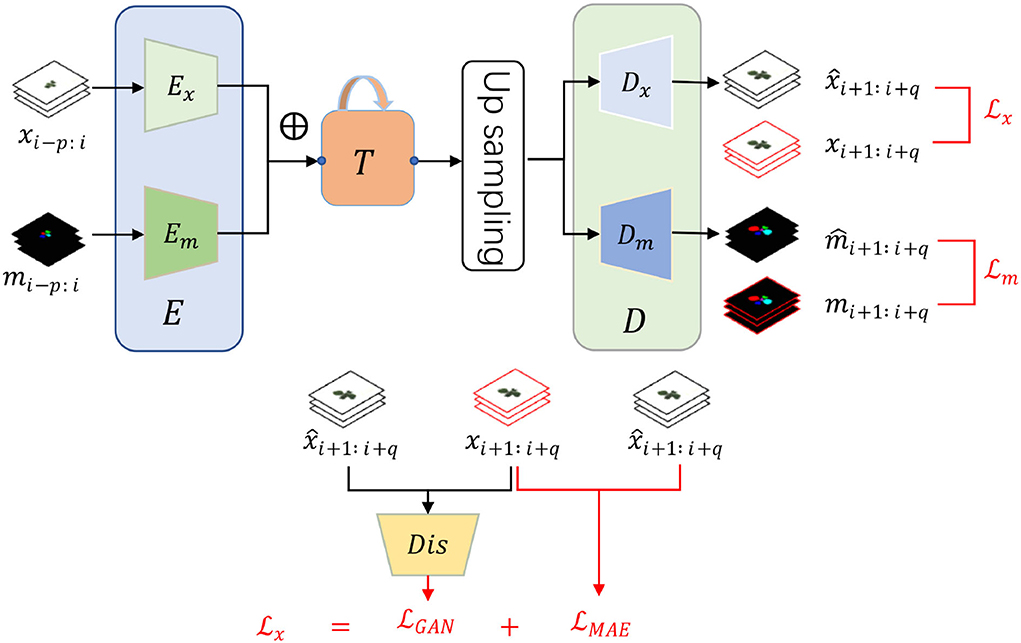
Figure 1. The framework and loss function of our proposed plant growth prediction model consist of three modules, input encoder E, output decoder D, and an intermediate time-series processing unit T. Encoder and decoder have an individual version of RGB image and instance mask because of the heterogeneity. There are two time-series inputs, historical RGB images xi−p : i and instance masks mi−p : i with two corresponding future predictions, RGB images and instance masks . ⊕ represents element-wise addition. To train the networks, we design two specific loss functions and for RGB images and instance masks, respectively.
To be more specific, we employ convolution neural networks (CNN) to form the encoders and decoders because of their excellent performance and good reputations in recent years (Krizhevsky et al., 2012; He et al., 2016). In terms of the time-series processing unit, Gated Recurrent Unit (GRU) in a CNN version is borrowed because of its smaller computations than LSTM. The structure of T is displayed in Figure 2 and can be split into two parts, time-series encoder TE and decoder TD. TE absorbs a series of input features Fi−p : i with several CGRU (CNN-based GRU) cells while TD sequentially predicts the future features Fi+1:i+q by taking the final output of the encoder. The details of each cell of CGRU can be found in the Supplementary Material. With the times-series encoder and decoder, our model is flexible to take length-changeable historical inputs and predict RGB images and instance masks with diverse time steps.

Figure 2. Structure of time-series processing unit T that is composed of a time-series encoder TE and decoder TD. With TE and TD, our model can predict different lengths of outputs with length-changeable inputs.
2.2. Loss function
As discussed in Section 1, we take the RGB images and instance masks in different ways to obtain high-quality predictions. To be more clear, we consider the RGB images from both time series and conditional image generation while thinking of predicting the instance masks as multi-class classification. Formally, two-loss functions are designed to train our model:
where and are the individual loss for RGB images and instance masks, respectively. To balance the two losses, two corresponding hyper-parameters are utilized, λx and λm.
First, our image loss function consists of two parts but in time-series, following paired image generation (Isola et al., 2017):
where is the image regression loss while aims to produce high-quality images. For image regression loss, L1 is borrowed as its resulting sharpen images as proved in (Isola et al., 2017). p(real) and p(gen) suggest the distribution of the real images and the predicted RGB images, respectively. Dis denotes the binary discriminator and the generator is our proposed prediction model, consisting of Ex, Em, T, and Dx, but without Dm. Different from general GAN loss with only one image (Isola et al., 2017; Xu et al., 2021), our objective is for q time-series image generation. Simultaneously, we use the following loss function, , to update the discriminator:
Second, a usual multi-class classification is utilized to optimize the instance mask prediction model:
where y is the corresponding instance label with ground truth class k. is the prediction score of instance masks produced by our model Dm.
2.3. Data augmentation method
As mentioned before, we recognize three key points to perform time-series data augmentation for plant growth prediction, time-series, growing character, and useful variations. Based on these three points, we propose two time-series data augmentation, T-Mixup, and T-Copy-Paste.
2.3.1. T-Mixup
Mixup (Zhang et al., 2018) can favor linear behavior in-between training samples and keep both features of two samples. Inspired by this idea, We propose T-Mixup by spatially fusing two adjacent frames to learn the intermediate states of the same leaf between different frames. It can be formulated as:
where λ, a value ranging from 0 to 1, denotes the merged ratio of two frames. Although it shows superiority in many applications, it results in unnatural images for human eyes (Yun et al., 2019) as shown in Figure 3. Furthermore, we assume that unnatural images are not beneficial to image generation, though it contributes to image classification without time-series. Therefore, we apply a different strategy to utilize the T-Mixup data augmentation. Specifically, we adopt T-Mixup only to pre-train our model, followed by finetuning all layers with natural RGB images and instance masks. The ablation study in the next section proves our assumption and our strategy.
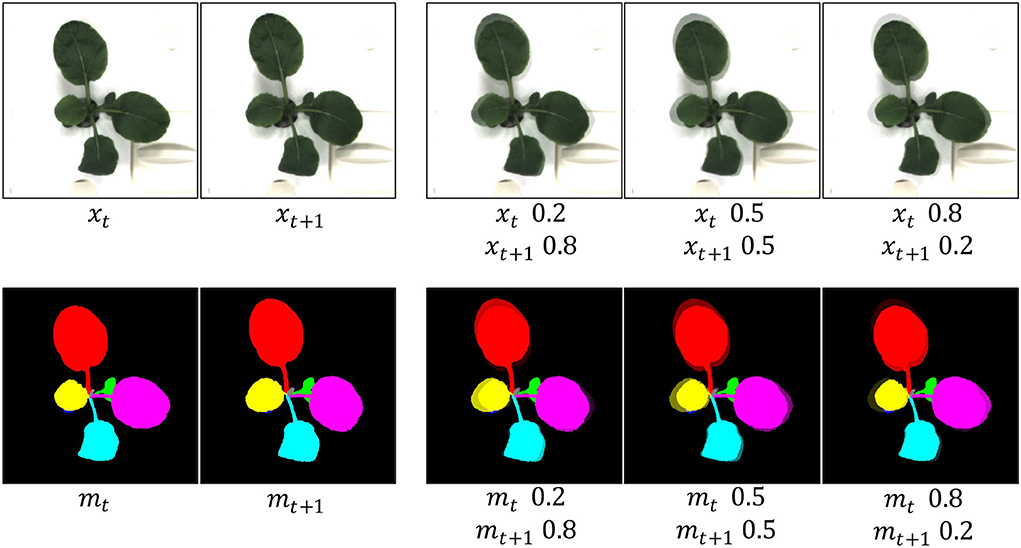
Figure 3. Generated examples of T-Mixup with the different merged ratios. The augmented RGB images and instance masks are not natural. Therefore, we only use T-Mixup in a pretraining process, followed by a finetuning process for all layers.
2.3.2. T-Copy-Paste
Copy-Paste (Ghiasi et al., 2021) is a powerful data augmentation method borrowed from the agricultural field (Kuznichov et al., 2019). However, it can not be intact to deploy in plant growth prediction due to the time-series character. To mitigate the challenge, we instead proposed a time-series copy-paste, termed T-Copy-Paste. As illustrated in Figure 4, T-Copy-Paste consists of two steps:
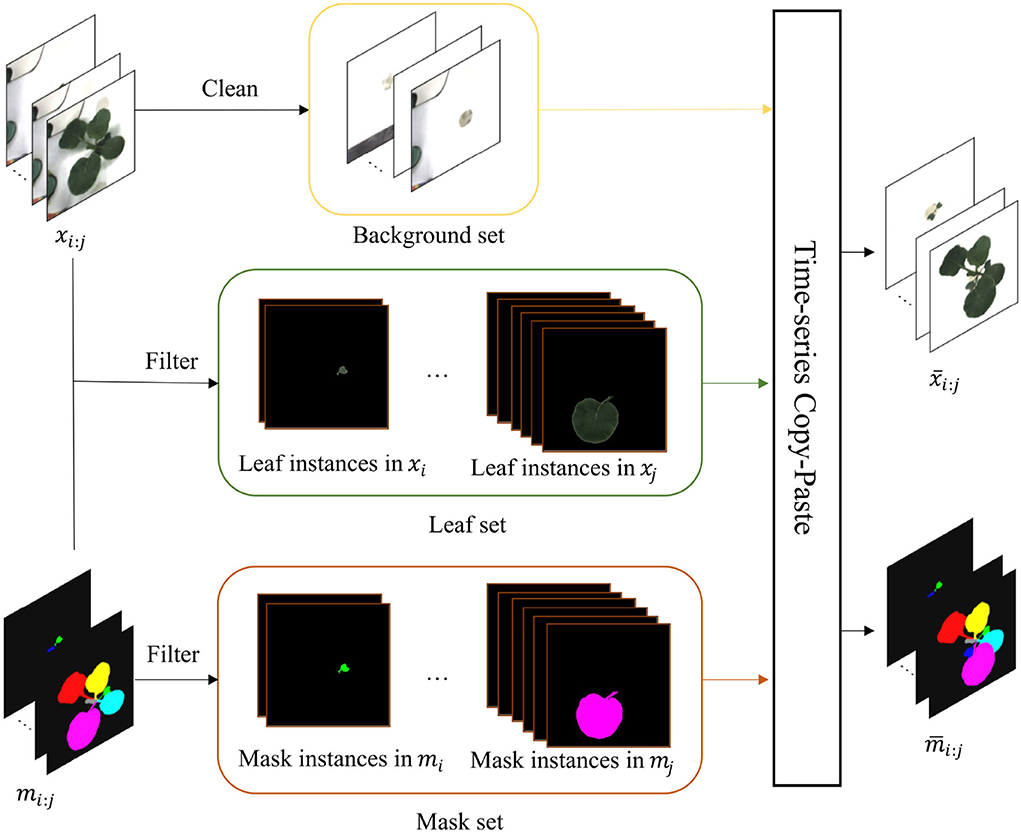
Figure 4. T-Copy-Paste data augmentation process. It consists of two steps: building up three sets of background, leaf, and mask, respectively from the given original dataset, and generating new RGB image and instance mask sequences by doing copy and paste of element(s) from the three sets sequentially over time. The xi : j and mi : j are the input sequences of RGB images and instance masks, respectively. After obtaining a clean background, suitable leaves, and their corresponding masks, we can generate new time-series images with copy and paste operation. The and denote generated new RGB image and instance mask sequences, respectively. Here, leaf-based data augmentation techniques can be applied together.
• Collect individual sets of background, leaf, and its corresponding mask from the existing dataset.
• Select randomly a background from the background set and sequentially paste a leaf (or leaves) chosen randomly from the leaf set and its (their) paired mask(s) to form new RGB images and instance mask images.
To collect clean background without any leaves, we utilize an open software, GNU Image Manipulation Program with a heal-selection filter plugin (National Bureau of Statistics, 2018), that can replace manually selected areas with their surrounding pixels. Some created backgrounds are shown in Figure 5. Different from making a background set, the leaf and mask set consist of leaf instances in RGB images and their corresponding instance masks, respectively. Every leaf is in a time series and paired with its corresponding instance mask. To choose the appropriate leaves and masks for the following operations, leaves that are partially invisible or divided into some parts due to overlapping leaves have been removed because it is difficult to recover them. We use a filter process to remove the undesired RGB images or instance masks, as shown in Figure 4.
After collecting the clean background, suitable leaves, and paired masks, we can produce a new set of time-series images consisting of RGB and mask that represent a plant by using the copy and paste operation. First, a background image is randomly selected and shared in time with the same plant. Then, leaf instances and their masks for the plant are selected, followed by random rotation or scale. Finally, they are copied and pasted to the chosen background to form a series of new RGB images and instance masks. The generated new RGB images and instance masks are illustrated in Figure 6.
3. Experiments
3.1. Experimental settings
3.1.1. Metric
We use three evaluation metrics to assess the proposed method's performance: Dice (Eelbode et al., 2020), peak-signal-to-noise ratio (PSNR), and the structural similarity index measure (SSIM) (Hore and Ziou, 2010). Specifically, the Dice coefficient is employed to quantify the performance of image segmentation, defined as twice the overlap area of predicted and ground truth over the total number of pixels in both images. In the plant growth prediction task, the generated leaves are more important than the background and thus we borrow Dice to measure the quality of generated plant leaves. PSNR is derived from MSE but is more sensitive to image noise. SSIM is used for measuring the similarity between two images. Generally, the higher the value of Dice, PSNR, and SSIM, the better the quality of the predicted image.
3.1.2. Dataset
We use KOMASTUNA (Uchiyama et al., 2017) dataset to evaluate our proposed model and data augmentation methods. The dataset contains 5 plants taken from the top and each plant consists of 60 frames acquired every 4 h in 10 days from 3 viewpoints. Besides, it also offers instance masks for each plant, in which the same label is assigned to the same leaf in all the frames and the label corresponds to the order of new leaves. In the dataset, plants have eight leaves at most, and therefore, eight is the number of classes to predict the instance mask. For the experiments, the original data are split into testing and training data at the plant level. We use 12-plant data for the training and 3-plant data for testing. Besides generic data augmentation, random rotation is utilized. The details are referred to the in Supplemental Material. Simultaneously, 40 plants in time-series are made with our proposed T-Copy-Paste data augmentation. The generic data augmentation and T-Copy-Paste are executed in an offline way while T-Mixup is in an online way.
3.1.3. Implementation details
In the training process, we use the AdamW optimizer to train our model for 200 epochs with a learning rate of 0.0001. The batch size is set as 4 with two RTX 3090 GPUs (24GB memory). The dropout is used in the convolution layer of the CGRU cell with a dropout rate of 0.2. We execute three times and report the mean and SD for each experiment. The training processing without our proposed data augmentation costs around 7 h while spending 21 h with the proposed data augmentation as the numbers of images and instance masks increased. By default, we predict one future frame by observing three historical frames.
3.1.4. Architecture details
The proposed plant growth prediction model consists of three sub-modules. First, the input encoder E consists of an image encoder Ex and mask encoder Em. Ex, expecting to extract features from plant RGB images, utilizes several stacks of convolutional layers and three residual blocks, while Em, aiming to extract features from instance masks, adopts the same number of stacks of convolutional layers only with one residual block since the mask is simpler than images. Second, the time-series processing unit T leverages a convolution-Sigmoid-GroupNorm and a convolution-Tanh-GroupNorm. Third, the output decoder D consists of image decoder Dx and mask decoder Dm. They employ two stacks of convolution-ReLU-BatchNorm. To recover the size of features after convolutional, the up-sampling operation is used which employs two up samplings with two stacks of convolution-ReLU-BatchNorm. We apply the discriminator in RGB image prediction processing to generate high-quality images and the details are referred to in Table 2. Finally, our prediction module (generator) and discriminator have about 13 and 2 million parameters.
3.2. Comparisons with other methods
In this subsection, we compare our method to the related articles, ConvLSTM (Sakurai et al., 2019), FutureGAN (Yasrab et al., 2021), STN-LSTM (Jung et al., 2022), and STN-STPD (Kim et al., 2022). The main characters of the articles refer to Table 1. For ConvLSTM, we rewrite the model and randomly train the model three times, and then report the mean performance. For other three articles, we directly borrow the evaluations from their articles as their codes are not public and executing details are not enough to reproduce. Similarly, direct comparison to Hamamoto et al. (2020a,b) is somehow hard, though they are more related to our method. Furthermore, depth information is required for the methods, and therefore, we do not compare with them. Besides, two video prediction methods, MC-Net (Villegas et al., 2017a) and HP-Net (Villegas et al., 2017b), are compared since video prediction is similar to plant growth prediction. The performances of the two articles are borrowed from Kim et al. (2022). For our method, we train our model three times and give the mean evaluations while the variance can be referred in the following subsections. All experiments are executed in the same dataset, KOMASTUNA (Uchiyama et al., 2017). The comparison results are displayed in Table 3.
From the table, we observe that the performances are gradually improved in recent years. In terms of predicting RGB images alone, shape information introduced in STN-LSTM (Jung et al., 2022) and STN-STPD (Kim et al., 2022) essentially improves the quality. In contrast, only using an instance mask may not be a good choice because of the poor mask PSNR in FutureGAN (Yasrab et al., 2021). We guess that RGB images have extra beneficial signals to predict instance masks. Finally, our method significantly surpasses the previous method by a clear margin on all evaluation metrics. In the following subsection, we analyze the reasons why our method contributes and the effectiveness of each module.
3.3. Ablation study
3.3.1. Hyperparameter
In this subsection, we analyze the impacts of hyperparameters. For this hyperparameter ablation study, the proposed data augmentation methods are not used. First, λMAE is adopted to balance the MAE loss and adversarial loss when generating the plant RGB images. Table 4 gives the performance and Figure 7 gives a visual comparison. From the table, the performances become better and then worse when λMAE gradually varies from 80 to 120. Especially, the model with λMAE = 100 achieves the best average Ipsnr 24.94, Mpsnr 27.02, and Dice 90.63. Visual comparison gives similar evidence that the generated RGB images have less noise and more details with λMAE = 100. For example, the biggest leaf in the latter stage in Figure 7 is better with the less missing part when λMAE equals 100, as well as the instance mask with a better shape.
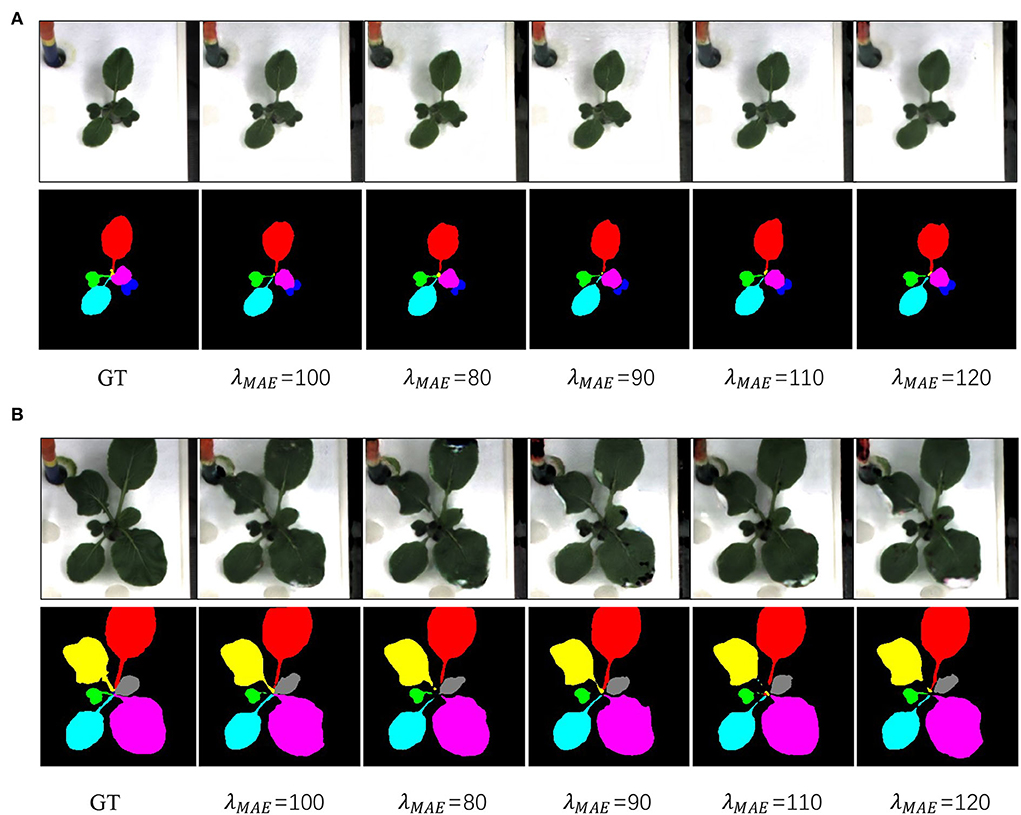
Figure 7. Qualitative results of different λMAE. Panels (A,B) are examples from the early stage, and latter stage, respectively. GT denotes the ground truth.
Second, we aim to get better qualities for both RGB image and instance mask via changing λx and λm. The ablation results are given in Table 5. The performance becomes better when RGB images are emphasized (λx is larger than λm). We argue that producing better RGB images is harder than instance masks as the RGB images have more details in a regression task.
3.3.2. Data augmentation
In this subsection, we analyze the impact of the proposed T-Copy-Past and T-Mixup data augmentation. The baseline employs basic data augmentation and random rotation, with which more details refer to the Supplementary Material. The experimental results are displayed in Table 6. Compared to the baseline, T-Mixup alone results in slightly worse performance for RGB images, such as the average Ipsnr varying from 24.94 to 24.86. In contrast, the finetuning strategy is beneficial to the performance, which suggests that plant growth is different from generic image classification and needs natural images to train the prediction model. Compared to T-Mixup, T-Copy-Paste contributes more to all performances. For example, it alone takes a 2.14 improvement of PSNR of RGB images than the baseline. The combination of finetuning of T-Mixup and T-Copy-Paste leads to the largest increase, which implies that a limited dataset is one challenge to have a better plant growth prediction model and our time-series data augmentation is one effective method.
3.3.3. Modules in our algorithm
Finally, we aim to distinguish the three main contributions in our paper, time-series, GAN, and data augmentation. The evaluation is given in Table 7 and the visual comparison is displayed in Figure 8. GAN can slightly improve the quality of RGB images and the instance masks. More interestingly, data augmentation leads to a huge improvement.

Table 7. Ablation study of our algorithm with three main contributions, time-series (TS), GAN, and the proposed time-series data augmentation (DA).
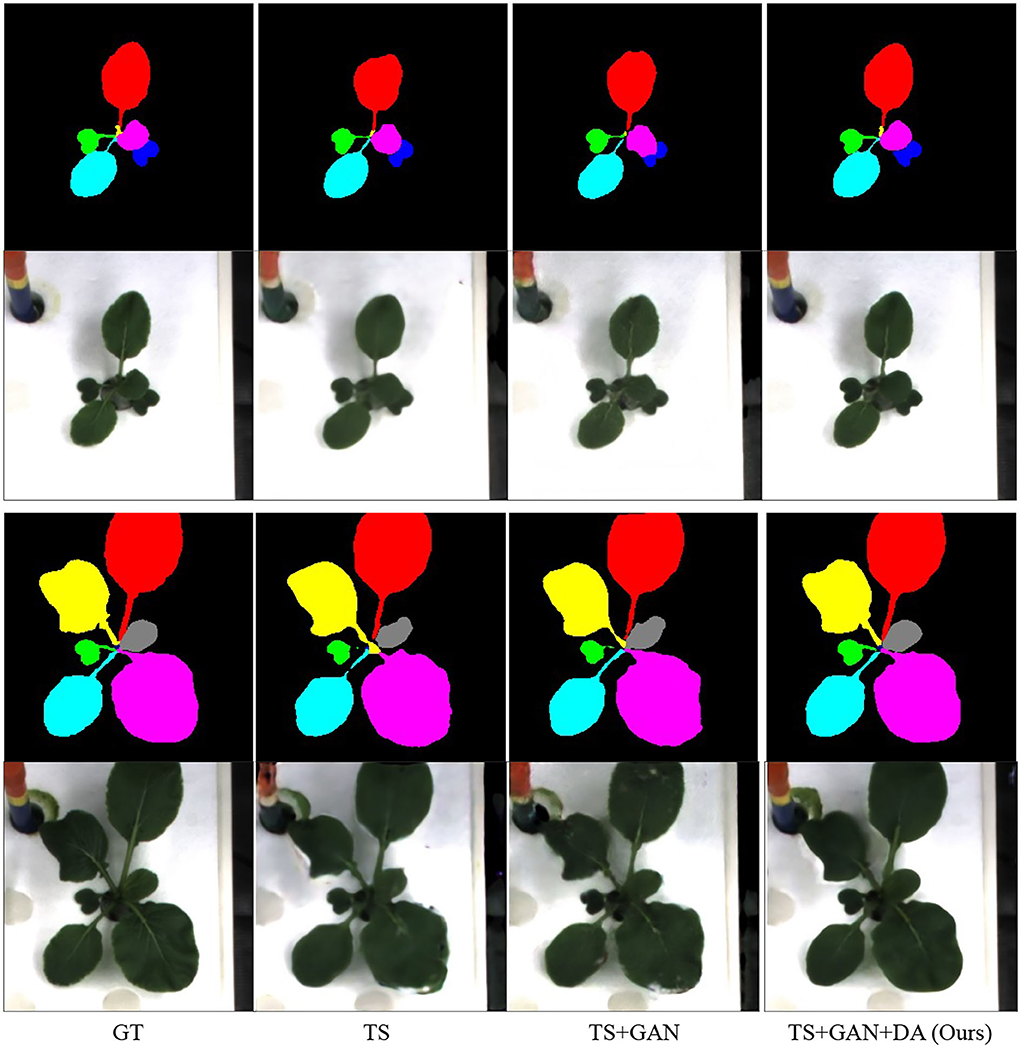
Figure 8. Ablation study of our algorithm. GT denotes the ground truth. TS and DA suggest time-series and our proposed time-series data augmentation.
3.4. Flexible plant growth prediction
As discussed in Section 1, we aim to achieve flexible plant growth prediction. In this case, we train our model to predict one future frame given three historical three frames, but we can test our model in a different case. By default, our model is tested in the same way (3to1), but we can also predict two future frames given three frames (3to2) without retraining the model, as well as in the 2to1 case. The testing performance in a different case is given in Table 8. The table suggests that more history benefits better performance and predicting more future frames is harder.
4. Conclusion
In this article, we considered the plant growth prediction from both time-series and image generation viewpoints to produce clear RGB images with a flexible framework. RGB images and instance masks of the leaf are predicted simultaneously, which suggests that our prediction is at leaf-level, instead of plant-level. With our model, we can flexibly predict different numbers of frames given diverse historical frames after training one specific model, such as predicting one frame given three input frames. Furthermore, we propose two time-series data augmentation, T-Mixup and T-Copy-Paste, to mitigate the limited dataset. Compared to the generic data augmentation such as rotation, the proposed T-Copy-Paste introduces specific variations for plant growth prediction, e.g., the spatial relations among leaves and the background. T-Mixup is related to the temporary information during plant growth and is only used to pretrain a model since the augmented images are not natural visually. The experimental results suggest that our method outperforms the current methods with a clear margin. To the best of our knowledge, we are the first ones to consider data augmentation for plant growth prediction. Especially, we believe that our data augmentation method, giving a bigger improvement than GAN, highlights the challenge of the limited dataset in plant growth prediction. In the future, we would like to validate our model in other possible datasets.
Data availability statement
Publicly available datasets were analyzed in this study. This data can be found here: https://ieeexplore.ieee.org/document/8265449.
Author contributions
YM conceived the idea, designed the algorithm, conducted all of the experiments, and wrote the manuscript. MX participated in the algorithm discussion and revised the manuscript. SY supervised the project and the overall improvement of the manuscript. YJ improved the manuscript. DP conceptualized the article, supervised the project, and got funding. All authors read and approved the manuscript.
Funding
This research was supported by Basic Science Research Program through the National Research Foundation of Korea (NRF) funded by the Ministry of Education (No. 2019R1A6A1A09031717). This study was supported by the National Research Foundation of Korea (NRF) grant funded by the Korean government (MSIT) (NRF-2021R1A2C1012174), the Korea Institute of Planning and Evaluation for Technology in Food, Agriculture and Forestry (IPET) and Korea Smart Farm Foundation (KosFarm) through the Smart Farm Innovation Technology Development Program, funded by the Ministry of Agriculture, Food and Rural Affairs (MAFRA) and Ministry of Science and ICT (MSIT), and Rural Development Administration (RDA) (421027-04).
Acknowledgments
We really appreciate the valuable suggestions from the reviewers and associate editor that improve the quality of this article.
Conflict of interest
The authors declare that the research was conducted in the absence of any commercial or financial relationships that could be construed as a potential conflict of interest.
Publisher's note
All claims expressed in this article are solely those of the authors and do not necessarily represent those of their affiliated organizations, or those of the publisher, the editors and the reviewers. Any product that may be evaluated in this article, or claim that may be made by its manufacturer, is not guaranteed or endorsed by the publisher.
Supplementary material
The Supplementary Material for this article can be found online at: https://www.frontiersin.org/articles/10.3389/fpls.2022.989304/full#supplementary-material
Footnotes
References
DeVries, T., and Taylor, G. W. (2017). Improved regularization of convolutional neural networks with cutout. arXiv preprint arXiv:1708.04552. doi: 10.48550/arXiv.1708.04552
Eelbode, T., Bertels, J., Berman, M., Vandermeulen, D., Maes, F., Bisschops, R., et al. (2020). Optimization for medical image segmentation: theory and practice when evaluating with dice score or jaccard index. IEEE Trans. Med. Imaging 39, 3679–3690. doi: 10.1109/TMI.2020.3002417
Ghiasi, G., Cui, Y., Srinivas, A., Qian, R., Lin, T.-Y., Cubuk, E. D., et al. (2021). “Simple copy-paste is a strong data augmentation method for instance segmentation,” in Proceedings of the IEEE/CVF Conference on Computer Vision and Pattern Recognition, 2918–2928. doi: 10.1109/CVPR46437.2021.00294
Goodfellow, I., Pouget-Abadie, J., Mirza, M., Xu, B., Warde-Farley, D., Ozair, S., et al. (2014). “Generative adversarial nets,” in Advances in Neural Information Processing Systems, Vol. 27, eds Z. Ghahramani, M. Welling, C. Cortes, N. Lawrence, and K.Q. Weinberger (Montreal, QC: Curran Associates). Available online at: https://proceedings.neurips.cc/paper/2014/file/5ca3e9b122f61f8f06494c97b1afccf3-Paper.pdf
Hamamoto, T., Uchiyama, H., Shimada, A., and Taniguchi, R.-I. (2020a). “3D plant growth prediction via image-to-image translation,” in VISIGRAPP (5: VISAPP) (Valletta), 153–161. doi: 10.5220/0008989201530161
Hamamoto, T., Uchiyama, H., Shimada, A., and Taniguchi, R.-I. (2020b). “RGB-D images based 3D plant growth prediction by sequential images-to-images translation with plant priors,” in International Joint Conference on Computer Vision, Imaging and Computer Graphics (Valletta: Springer), 334–352. doi: 10.1007/978-3-030-94893-1_15
He, K., Zhang, X., Ren, S., and Sun, J. (2016). “Deep residual learning for image recognition,” in Proceedings of the IEEE Conference on Computer Vision and Pattern Recognition (Las Vegas, NV), 770–778. doi: 10.1109/CVPR.2016.90
Hore, A., and Ziou, D. (2010). “Image quality metrics: PSNR vs. SSIM,” in 2010 20th International Conference on Pattern Recognition (Istanbul: IEEE), 2366–2369. doi: 10.1109/ICPR.2010.579
Isola, P., Zhu, J.-Y., Zhou, T., and Efros, A. A. (2017). “Image-to-image translation with conditional adversarial networks,” in Proceedings of the IEEE Conference on Computer Vision and Pattern Recognition (Honolulu, HI), 1125–1134. doi: 10.1109/CVPR.2017.632
Jung, J.-Y., Lee, S.-H., Kim, T.-H., Oh, M.-M., and Kim, J.-O. (2022). Shape based deep estimation of future plant images. IEEE Access 10, 4763–4776. doi: 10.1109/ACCESS.2022.3140464
Kim, T., Lee, S.-H., and Kim, J.-O. (2022). A novel shape based plant growth prediction algorithm using deep learning and spatial transformation. IEEE Access 10, 37731–37742. doi: 10.1109/ACCESS.2022.3165211
Krizhevsky, A., Sutskever, I., and Hinton, G. E. (2012). “Imagenet classification with deep convolutional neural networks,” in Advances in Neural Information Processing Systems, Vol. 25, eds F. Pereira, C. J. Burges, L. Bottou, and K.Q. Weinberger (Lake Tahoe, CA: Curran Associates). Available online at: https://proceedings.neurips.cc/paper/2012/file/c399862d3b9d6b76c8436e924a68c45b-Paper.pdf
Kuznichov, D., Zvirin, A., Honen, Y., and Kimmel, R. (2019). “Data augmentation for leaf segmentation and counting tasks in rosette plants,” in Proceedings of the IEEE/CVF Conference on Computer Vision and Pattern Recognition Workshops Long Beach, CA. doi: 10.1109/CVPRW.2019.00314
National Bureau of Statistics (2018). Gimp Resynthesizer Plugin Suite. Available online at: https://github.com/bootchk/resynthesizer
Ruder, S. (2017). An overview of multi-task learning in deep neural networks. arXiv preprint arXiv:1706.05098. doi: 10.48550/arXiv.1706.05098
Sachs, J., Kroll, C., Lafortune, G., Fuller, G., and Woelm, F. (2022). Sustainable Development Report 2022. Cambridge University Press. doi: 10.1017/9781009210058
Sakurai, S., Uchiyama, H., Shimada, A., and Taniguchi, R.-I. (2019). “Plant growth prediction using convolutional LSTM,” in VISIGRAPP (5: VISAPP) (Funchal), 105–113. doi: 10.5220/0007404901050113
Somov, A., Shadrin, D., Fastovets, I., Nikitin, A., Matveev, S., Hrinchuk, O., et al. (2018). Pervasive agriculture: IoT-enabled greenhouse for plant growth control. IEEE Pervas. Comput. 17, 65–75. doi: 10.1109/MPRV.2018.2873849
Uchiyama, H., Sakurai, S., Mishima, M., Arita, D., Okayasu, T., Shimada, A., et al. (2017). “An easy-to-setup 3D phenotyping platform for komatsuna dataset,” in Proceedings of the IEEE International Conference on Computer Vision Workshops (Venice), 2038–2045. doi: 10.1109/ICCVW.2017.239
Villegas, R., Yang, J., Hong, S., Lin, X., and Lee, H. (2017a). “Decomposing motion and content for natural video sequence prediction,” in 5th International Conference on Learning Representations, ICLR 2017 Toulon.
Villegas, R., Yang, J., Zou, Y., Sohn, S., Lin, X., and Lee, H. (2017b). “Learning to generate long-term future via hierarchical prediction,” in International Conference on Machine Learning (Seoul: PMLR), 3560–3569.
Wu, Y., and He, K. (2018). “Group normalization,” in Proceedings of the European Conference on Computer Vision (ECCV) (Munich), 3–19. doi: 10.1007/978-3-030-01261-8_1
Xu, M., Yoon, S., Fuentes, A., and Park, D. S. (2022). A comprehensive survey of image augmentation techniques for deep learning. arXiv preprint arXiv:2205.01491. doi: 10.48550/arXiv.2205.01491
Xu, M., Yoon, S., Fuentes, A., Yang, J., and Park, D. S. (2021). Style-consistent image translation: a novel data augmentation paradigm to improve plant disease recognition. Front. Plant Sci. 12, 773142. doi: 10.3389/fpls.2021.773142
Yasrab, R., Zhang, J., Smyth, P., and Pound, M. P. (2021). Predicting plant growth from time-series data using deep learning. Remote Sens. 13, 331. doi: 10.3390/rs13030331
Yun, S., Han, D., Oh, S. J., Chun, S., Choe, J., and Yoo, Y. (2019). “Cutmix: regularization strategy to train strong classifiers with localizable features,” in Proceedings of the IEEE/CVF International Conference on Computer Vision (Seoul), 6023–6032. doi: 10.1109/ICCV.2019.00612
Keywords: plant growth prediction, deep learning, data augmentation, T-Mixup, T-Copy-Paste, generative adversarial loss
Citation: Meng Y, Xu M, Yoon S, Jeong Y and Park DS (2022) Flexible and high quality plant growth prediction with limited data. Front. Plant Sci. 13:989304. doi: 10.3389/fpls.2022.989304
Received: 08 July 2022; Accepted: 19 August 2022;
Published: 12 September 2022.
Edited by:
Claus Zebitz, University of Hohenheim, GermanyReviewed by:
Ricard Durall, Fraunhofer ITWM, GermanyAbhipray Paturkar, Massey University, New Zealand
Copyright © 2022 Meng, Xu, Yoon, Jeong and Park. This is an open-access article distributed under the terms of the Creative Commons Attribution License (CC BY). The use, distribution or reproduction in other forums is permitted, provided the original author(s) and the copyright owner(s) are credited and that the original publication in this journal is cited, in accordance with accepted academic practice. No use, distribution or reproduction is permitted which does not comply with these terms.
*Correspondence: Sook Yoon, c3lvb25AbW9rcG8uYWMua3I=; Dong Sun Park, ZHNwYXJrQGpibnUuYWMua3I=
 Yao Meng
Yao Meng Mingle Xu
Mingle Xu Sook Yoon
Sook Yoon Yongchae Jeong4
Yongchae Jeong4 Dong Sun Park
Dong Sun Park
